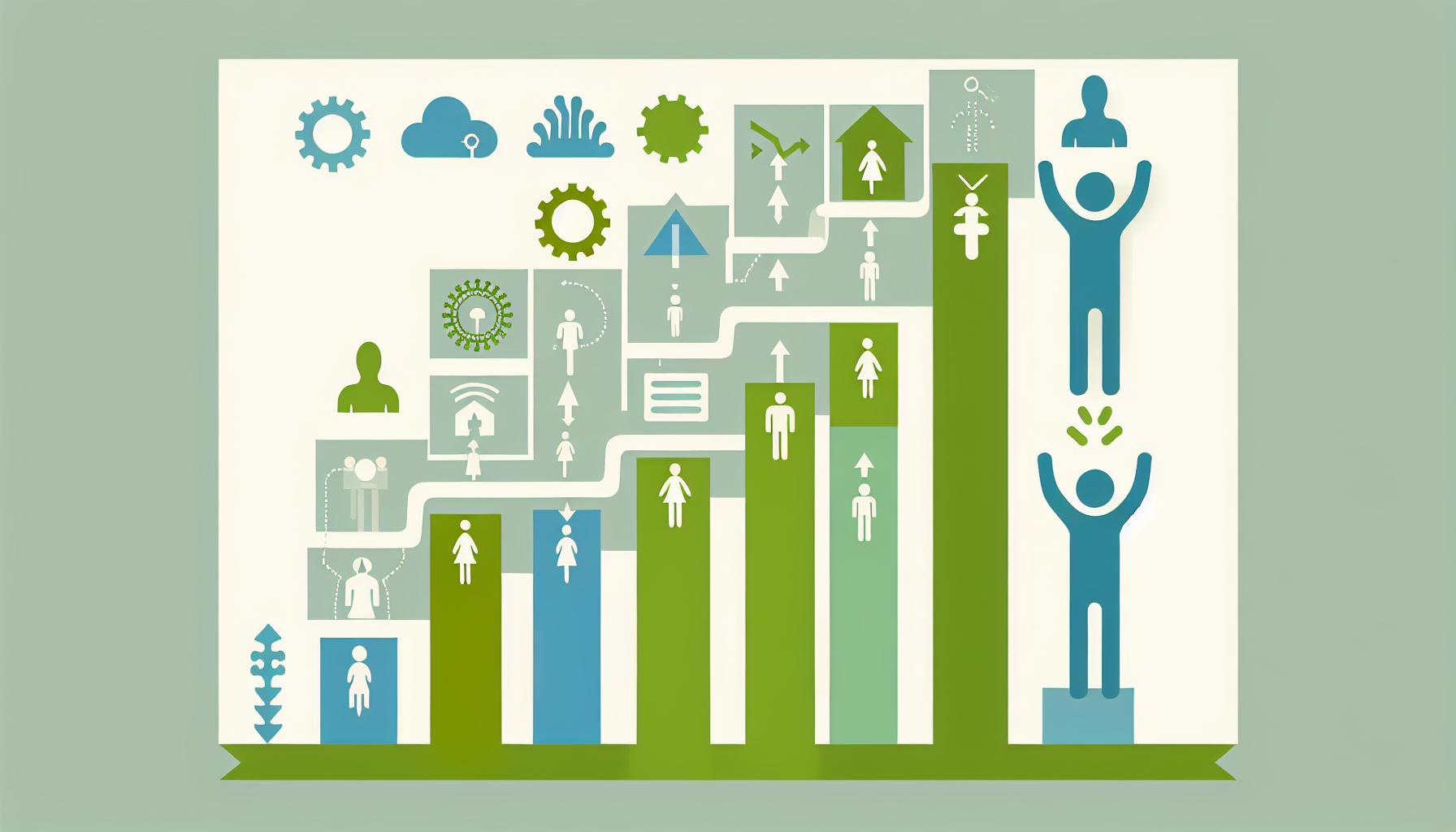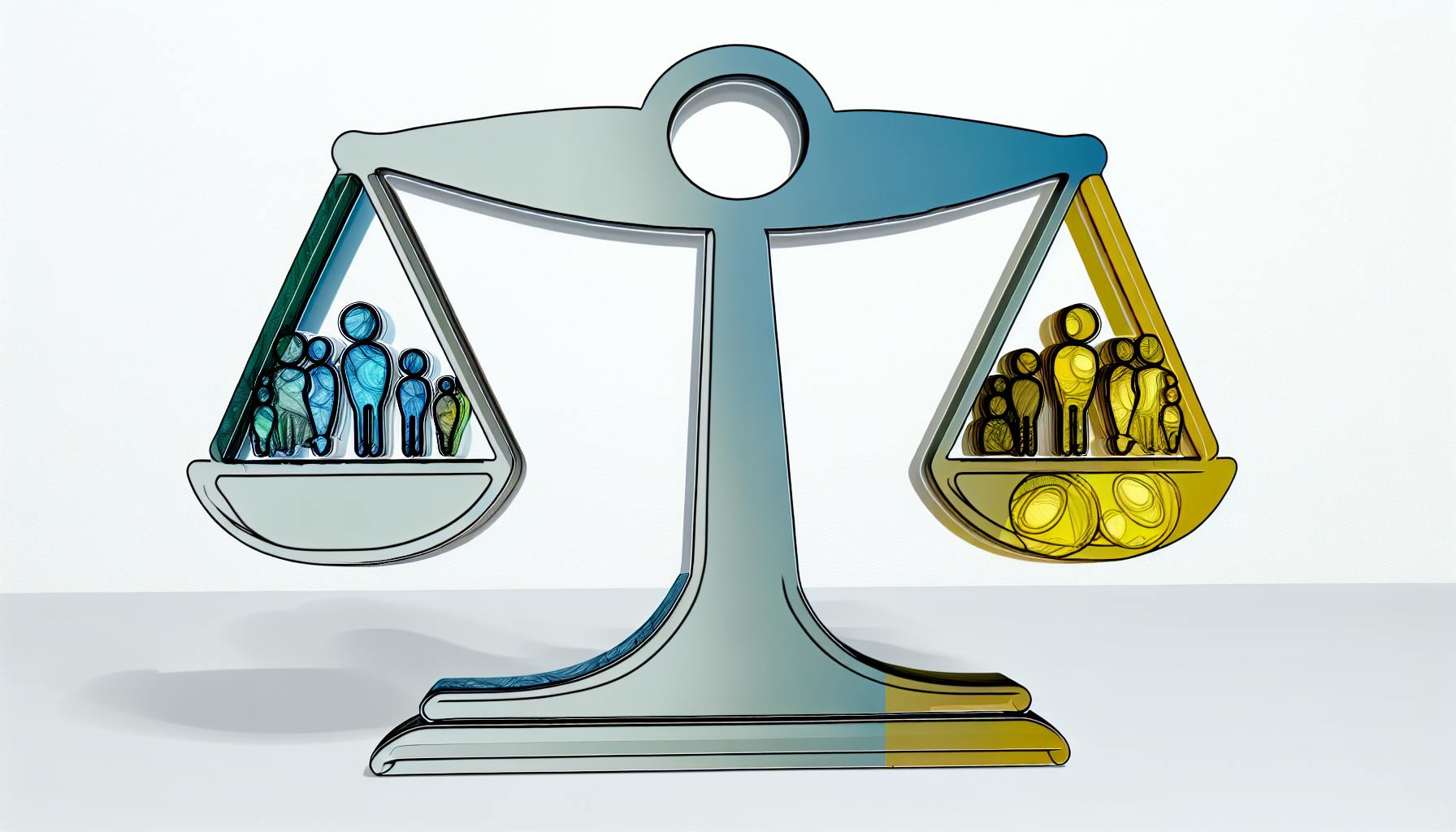Most companies understand the challenge of retaining top talent in a competitive job market.
By optimizing your employee total rewards program and emphasizing intrinsic motivators, you can increase engagement and retention.
In this article, we'll define total rewards, discuss innovative examples from leading companies, and provide best practices for crafting a competitive and compelling total rewards strategy.
Introduction to Innovative Employee Total Rewards
Employee total rewards encompass all forms of compensation, benefits, and perks provided to employees in exchange for their work. As the job market grows more competitive, organizations need to develop strong total rewards programs to attract and retain top talent. This section will provide an overview of innovative employee total rewards and why they are critical for talent retention.
Defining Employee Total Rewards
Employee total rewards include:
- Compensation - wages, salaries, bonuses, commissions, and stock options
- Benefits - health insurance, retirement plans, paid time off, tuition reimbursement, and childcare
- Recognition - performance awards, gift cards, public praise
- Development - training, mentoring, tuition assistance
- Work-life balance - flexible schedules, remote work options
Total rewards incorporate both tangible and intangible rewards beyond just a paycheck. The most effective programs align rewards to employee preferences and organizational values.
The Importance of Total Rewards for Retention
With the employee total rewards job market being extremely competitive, total rewards are essential for talent retention. Key reasons why total rewards matter:
- Attract top candidates in scarce talent pools
- Incentivize employee performance, engagement, and loyalty
- Support recruitment, retention, and company growth
- Build an appealing and unique employer brand
- Enable flexibility to meet diverse employee needs
- Boost productivity, innovation, and bottom-line results
Organizations that fail to offer competitive total rewards will struggle to retain their best people.
Current Trends in Total Rewards
Leading companies are optimizing their total rewards through strategies like:
- Personalization - customizing rewards based on individual needs and preferences
- Work-life integration - providing more flexibility and remote work options
- Wellbeing - prioritizing health, stress management, mental health benefits
- Equity - ensuring rewards are inclusive and equitable across all demographics
- Recognition - formal and informal programs to recognize achievements
- Development - upskilling programs, career development opportunities
- Communication - clearly conveying the value of the total rewards package
The most innovative companies take a holistic approach to engage each employee as an individual.
What are the 5 total rewards?
The concept of total rewards encompasses all aspects of employee compensation and benefits. Here are the 5 key elements of a total rewards model:
Compensation
This includes an employee's base salary, bonuses, commissions, and other monetary compensation. Competitive compensation is essential for attracting and retaining top talent.
Benefits
Benefits refer to health insurance, retirement plans, paid time off, employee perks, and other non-cash incentives provided by employers. Robust benefits can increase employee satisfaction and loyalty.
Work-Life Balance
Initiatives that promote work-life balance allow employees to better manage their personal and professional responsibilities. Examples include flexible schedules, remote work options, and generous vacation policies.
Performance and Recognition
Performance management, including feedback, coaching, and rewards for strong performance enables employees to develop their skills. Public recognition programs also motivate staff.
Development and Career Opportunities
Investment in employee growth through training, mentoring, and internal mobility programs helps talent reach their potential. This strengthens an organization's bench strength.
An effective total rewards strategy incorporates all five elements above. The mix should align with employee preferences and support business goals. Rethinking total rewards can be a competitive advantage in recruiting and retaining top performers.
What is an example of a total rewards strategy?
A total rewards strategy aims to provide employees with compensation, benefits, and other incentives beyond just a paycheck. This holistic approach can boost employee satisfaction, engagement, and retention. Here is an example of an effective total rewards program:
Monetary and Non-Monetary Rewards
- Competitive salaries benchmarked to industry and location
- Bonuses or incentive pay for high performers
- Stock options to share in company success
- Paid time off including vacations, sick days, and holidays
- Flexible work arrangements like remote work and flexible schedules
Health and Wellbeing
- Comprehensive medical/dental/vision insurance
- Wellness reimbursements for gym memberships or fitness apps
- Health screenings and flu shot clinics
- Employee assistance programs providing counseling and referrals
Career Development
- Tuition reimbursement for advanced degrees and certifications
- Training programs to build new skills
- Mentorship opportunities to get guidance from leaders
- Career coaching and development planning
Work Culture
- Employee resource groups bringing people together by shared interests
- Volunteer days to give back to the community
- Work celebrations like parties, award ceremonies, and team outings
The most successful total rewards programs evolve based on regular employee feedback surveys. This ensures the incentives match what will best motivate and retain top talent.
What are examples of employee rewards?
Here are some low-cost ways to reward employees and boost engagement:
- Public recognition: Give shoutouts to top performers in team meetings or the company newsletter. This costs nothing and makes employees feel valued.
- Handwritten notes: Write personal thank you cards to highlight specific contributions. This thoughtful gesture shows employees their work matters.
- Time off: Offer half-days or extra PTO as a reward for completing big projects. The break allows employees to recharge.
- Small gifts: Things like gift cards, movie tickets, or lunch are affordable ways to celebrate wins.
- Commuting benefits: Consider subsidizing transit or parking costs for employees. This recurring perk really adds up.
- Chair massages: Bring in massage therapists for short sessions. It's an inexpensive way to promote self-care and relaxation at work.
- Spotlights: Feature exceptional employees and their achievements on the company blog or in newsletters. It's great exposure.
- Team events: Host activities like trivia, bowling nights, or picnics to boost morale. Bonding experiences are powerful motivators.
The most meaningful rewards do not have to be costly. Simple efforts to recognize, connect with, and invest in your people can go a long way. Focus on understanding what makes each employee feel happiest and most fulfilled at work.
What is total rewards vs compensation?
Total rewards encompass all the monetary and non-monetary returns provided to employees in exchange for their time, talents, efforts and results. This includes:
- Compensation: Base pay, bonuses, equity, overtime, commissions, etc.
- Benefits: Health insurance, retirement plans, paid time off, employee assistance programs, etc.
- Career development: Training, mentoring, tuition reimbursement, certifications, etc.
- Work-life balance: Flexible schedules, remote work options, employee resource groups, etc.
- Recognition: Awards, spot bonuses, peer-to-peer recognition, celebrations, etc.
In contrast, compensation refers specifically to an employee's financial pay including wages, salaries, bonuses and equity.
So in summary:
- Total rewards consist of compensation plus additional workplace perks spanning various areas like benefits, growth, culture and appreciation.
- Compensation is the monetary component that makes up a portion of the total rewards experience.
Getting the total rewards mix right is key for attracting and retaining top talent in a competitive hiring landscape. The most successful companies provide compelling holistic employee value propositions with incentives that appeal to a diverse workforce.
sbb-itb-d78b90b
Components of a Strong Total Rewards Strategy
This section outlines the key elements to include in a strategic employee total rewards program designed to boost talent attraction and retention.
Competitive Salaries
Offering fair and equitable pay that matches or exceeds industry standards is the foundation of any solid total rewards program. Conduct regular market research and benchmarking to ensure compensation levels align to roles, experience levels and geographic regions. Leverage data and compensation best practices to mitigate bias and close existing pay gaps across gender, race and other demographics.
Performance Bonuses
Tying financial rewards directly to individual and company performance through annual bonuses or incentive pay can powerfully boost engagement and retention. Set clear goals and key performance indicators (KPIs) for employees that align to organizational objectives. Track progress transparently, and payout rewards proportionately to results achieved.
Creative Benefits Packages
Go beyond standard medical and retirement benefits to meet diverse employee needs and lifestyles. Consider offerings like pet insurance, fertility assistance, paid sabbaticals, unlimited vacation days, gym memberships, continuing education stipends, and more. Get innovative with the perks you provide.
Flexible Work Arrangements
With remote and hybrid work models now commonplace, flexibility around when and where work gets done has become highly valued by today's workforce. Offer options like compressed work weeks, job sharing, telecommuting and adjusted start/end times. Support work-life balance and empower employees with autonomy.
Career Growth Opportunities
Investment in continuous learning and clear paths for advancement are vital for talent retention. Offer mentorship programs, skills training, rotational assignments and stretch opportunities. Promote from within whenever possible, and help employees map long-term career trajectories. Upskilling your people wins loyalty.
Total Reward Optimization for Employee Retention
Aligning Rewards with Workforce Demographics
Tailoring total rewards to meet the needs of different generational groups can improve employee retention. For example, millennials often prioritize flexibility, remote work options, and career development opportunities. Meanwhile, Gen Xers may appreciate childcare benefits, retirement matching, and sabbaticals more.
Companies can conduct employee surveys and focus groups to better understand the reward preferences of their unique workforce demographics. This data can inform the design of specialized total rewards programs catered to what motivates and retains each employee group.
The Role of Data in Reward Optimization
Analytics help companies structure data-driven total rewards programs. Useful metrics to analyze include:
- Employee satisfaction scores
- Turnover and retention rates
- Utilization of existing rewards
- Competitor compensation packages
By benchmarking against industry standards and monitoring program performance over time, organizations can optimize their offerings based on real employee preferences.
Continuous Improvement of Total Rewards
As employee expectations evolve, an agile approach to total rewards is essential. Regular program evaluations and enhancements should become an ingrained business process.
Some best practices include:
- Annual focus groups and surveys
- Dynamic benchmarking against competitor rewards
- Testing new benefit offerings with pilot groups
- Tweaking programs based on utilization analytics
This culture of continuous listening and improvement enables companies to keep rewards competitive amidst shifting talent market dynamics. The result is sustained employee satisfaction, engagement, and retention over the long term.
Why are Total Rewards Important to Employees?
Beyond the Paycheck: The Psychological Impact
A comprehensive total rewards program goes beyond compensation to fulfill other critical psychological needs for employees. This includes:
- Recognition: Public acknowledgement and appreciation for excellent work makes employees feel valued. Simple "thank yous" from leadership can boost morale.
- Growth opportunities: Investing in development programs and clear promotion paths caters to employees' need for self-actualization. This strengthens their bond with the organization.
- Work-life balance: Flexible schedules, remote work options, and generous time-off policies empower employees to pursue personal goals alongside professional ones. This reduces burnout.
- Inclusion and belonging: Fostering diversity, equity and inclusion makes the workplace somewhere employees feel comfortable bringing their whole, authentic selves. This promotes engagement and retention.
When these psychological needs are met through total rewards, employees feel invested in and loyal to the organization.
Total Rewards as a Reflection of Company Culture
An organization's total rewards structure communicates what it values, making it a reflection of company culture. For example:
- Emphasis on learning/development incentives indicates a culture embracing growth and innovation.
- Robust healthcare coverage signals a focus on wellbeing and work-life balance.
- Bonuses tied to sustainability goals reflect a commitment to social responsibility.
By aligning rewards to cultural pillars in this way, organizations demonstrate authenticity. Employees recognize integrity between espoused and enacted values, earning trust.
The Connection Between Rewards and Employee Engagement
Research shows total rewards substantially impacts employee engagement:
- Employees receiving fair pay and benefits are 5x more likely to feel committed and deliver discretionary effort.
- Those provided learning/career growth support become 7x more likely to stay long-term.
- Flexible policies lead to 13% higher engagement scores.
- Rewards/recognition for top talent makes them 21% more engaged.
With such a direct link between thoughtful total rewards and heightened engagement, the business case is clear: investing in employees through compensation, benefits, and beyond also invests in organizational success.
Employee Total Rewards Examples: Real-World Applications
Tech Giants and Their Tailored Reward Systems
Tech companies are known for offering innovative employee total rewards to attract and retain top talent. Here are some examples:
- Google provides employees with free meals, onsite fitness centers, healthcare, equity, and generous parental leave. This creates an attractive work environment.
- Facebook has an employee total rewards program focused on wellness. They provide healthy meals, access to gyms, and even onsite healthcare. This helps keep employees healthy and engaged.
- Microsoft empowers employees by giving them equity stakes early on. This makes employees feel invested in the company's success.
By tailoring their rewards programs to employee needs, these tech giants are better able to recruit and retain the best talent.
Innovative Startups: Agility in Total Rewards
Startups have to get creative with their employee total rewards to compete for talent with limited resources. For example:
- Uber provides bonuses based on performance metrics for drivers. This rewards top performers.
- Airbnb allows remote work and unlimited vacation time. This flexibility is attractive for potential hires.
- Coinbase gives employees a portion of their salary in cryptocurrency. This is an innovative way to reward belief in the company mission.
With tailored and flexible employee total rewards strategies, startups can punch above their weight in attracting talent.
Traditional Industries Embracing Change
Even old-economy companies are evolving their employee total rewards to stay competitive:
- Walmart increased wages and implemented training programs. This shows an investment in frontline workers.
- General Motors focused on profit-sharing and transparency. This rewards all employees for performance.
- Target enhanced healthcare coverage and retirement contributions. This takes care of employee wellbeing long-term.
By rethinking employee total rewards, traditional companies can boost retention and engagement within their evolving workforce.
Crafting a Total Rewards Statement: Examples and Best Practices
Elements of an Effective Total Rewards Statement
An effective total rewards statement clearly communicates the complete compensation package to employees. Key elements to include:
- Overview of compensation components: Base salary, bonuses, equity, retirement contributions, health insurance, wellness programs, tuition reimbursement, etc. Highlight key parts of the package.
- Employee benefits breakdown: Provide details on health insurance plans, retirement contributions, equity awards, wellness program offerings, etc.
- Clear valuation: Show the cumulative value of the total rewards package, including all compensation, benefits, perks and programs.
- Company culture: Articulate company values, growth opportunities, work flexibility, remote work options, diversity and inclusion initiatives, etc.
- Concise communication: Use simple language, relatable examples, infographics and summaries to enhance clarity.
Total Rewards Statement Examples from Top Employers
Leading companies effectively present their total rewards:
- Google highlights their compensation philosophy, benefits offerings, learning opportunities, facilities, wellness programs and work culture.
- Microsoft created total rewards videos and statements tailored to different employee groups based on life stage.
- IBM provides a personalized total rewards statement showing the complete value of each employee's compensation and benefits package.
- Accenture shares total rewards information in an engaging mobile app with summaries, videos and retirement modeling tools.
Best Practices for Communicating Total Rewards
Strategies for ensuring employees understand their total rewards:
- Send annual personalized statements detailing complete compensation value.
- Provide interactive online portals for modeling different benefits selections.
- Use multiple formats like videos, presentations, emails and apps to expand reach.
- Conduct employee surveys to identify gaps in understanding total rewards.
- Set up Q&A sessions for clarifying details on equity, bonuses, retirement plans, etc.
- Update managers on total rewards details to enable coaching conversations.
Clearly articulating the total value of compensation and benefits is key for talent retention. Following best practices builds employee loyalty.
Key Takeaways for Developing an Innovative Total Rewards Program
In this section, we'll summarize the major lessons for creating a competitive and creative employee total rewards strategy.
Offer Both Traditional and Innovative Rewards
Balance foundational compensation with new, value-added perks tailored to a modern, diverse workforce. Some ideas:
- Provide competitive salaries along with unique benefits like paid sabbaticals, volunteer time off, home office stipends, etc.
- Offer the standard health/dental/vision insurance with cutting-edge wellness incentives focused on mental, financial, social, and physical health.
- Structure traditional retirement contributions to also allow flexibility for other savings goals like college, home ownership, travel, etc.
Personalize and Customize
Provide flexibility and choice in benefits while enabling managers to recognize individual needs and contributions. Tactics include:
- Allowing employees to select the benefits that matter most to them from a menu.
- Empowering managers to provide spot bonuses, gift cards, and extra time off to reward great work.
- Considering flexible work schedules on a case-by-case basis.
Focus on Intrinsic Motivators Too
Compensation is important, but purpose, growth, autonomy and belonging are also key total rewards to boost retention. Ideas:
- Provide training, mentorship, and career development planning.
- Recognize contributions publicly in meetings and newsletters.
- Encourage work/life balance and promote a positive culture.
- Give employees a voice through engagement surveys and focus groups.


